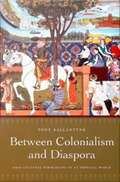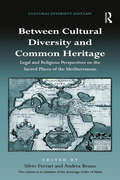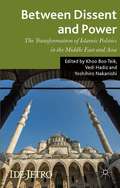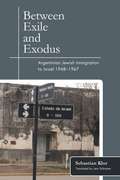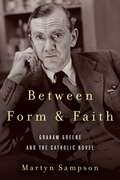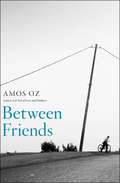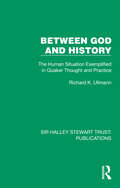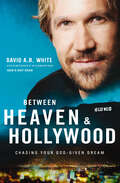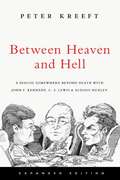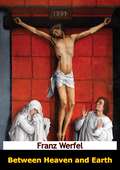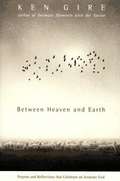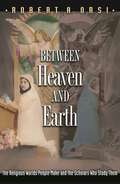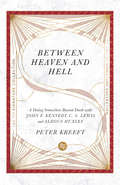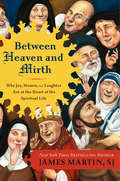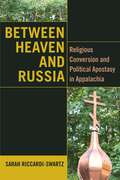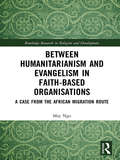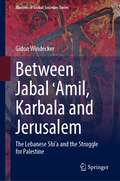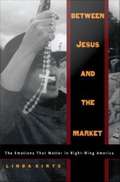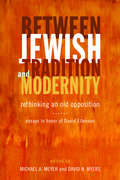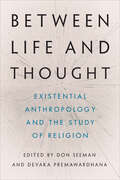- Table View
- List View
Between Colonialism and Diaspora: Sikh Cultural Formations in an Imperial World
by Tony BallantyneTony Ballantyne is Senior Lecturer in History at the University of Otago in New Zealand. He is the author of Orientalism and Race: Aryanism in the British Empire and a coeditor of Bodies in Contact: Rethinking Colonial Encounters in World History, also published by Duke University Press.
Between Cultural Diversity and Common Heritage: Legal and Religious Perspectives on the Sacred Places of the Mediterranean (Cultural Diversity and Law)
by Silvio FerrariGoing beyond the more usual focus on Jerusalem as a sacred place, this book presents legal perspectives on the most important sacred places of the Mediterranean. The first part of the book discusses the notion of sacred places in anthropological, sociological and legal studies and provides an overview of existing legal approaches to the protection of sacred places in order to develop and define a new legal framework. The second part introduces the meaning of sacred places in Jewish, Christian and Islamic thought and focuses on the significance and role that sacred places have in the three major monotheistic religions and how best to preserve their religious nature whilst designing a new international statute. The final part of the book is a detailed analysis of the legal status of key sacred places and holy cities in the Mediterranean area and identifies a set of legal principles to support a general framework within which specific legal measures can be implemented. The book concludes with a useful appendix for the protection of sacred places in the Mediterranean region. Including contributions from leading law and religion scholars, this interesting book will be valuable to those in the fields of international law, as well as religion and heritage studies.
Between Dignity and Despair: Jewish Life in Nazi Germany
by Marion A. KaplanBetween Dignity and Despair draws on the extraordinary memoirs, diaries, interviews, and letters of Jewish women and men to give us the first intimate portrait of Jewish life in Nazi Germany. Kaplan tells the story of Jews in Germany not from the hindsight of the Holocaust, nor by focusing on the persecutors, but from the bewildered and ambiguous perspective of Jews trying to navigate their daily lives in a world that was becoming more and more insane. Answering the charge that Jews should have left earlier, Kaplan shows that far from seeming inevitable, the Holocaust was impossible to foresee precisely because Nazi repression occurred in irregular and unpredictable steps until the massive violence of November 1938. Then the flow of emigration turned into a torrent, only to be stopped by the war. By that time Jews had been evicted from their homes, robbed of their possessions and their livelihoods, shunned by their former friends, persecuted by their neighbors, and driven into forced labor. For those trapped in Germany, mere survival became a nightmare of increasingly desperate options. Many took their own lives to retain at least some dignity in death; others went underground and endured the fears of nightly bombings and the even greater terror of being discovered by the Nazis. Most were murdered. All were pressed to the limit of human endurance and human loneliness. Focusing on the fate of families and particularly women's experience, Between Dignity and Despair takes us into the neighborhoods, into the kitchens, shops, and schools, to give us the shape and texture, the very feel of what it was like to be a Jew in Nazi Germany.
Between Dissent and Power
by Vedi R. Hadiz Khoo Boo Teik Yoshihiro NakanishiThis study examines the collective progression of Islamic politics between points of dissent and positions of power. It brings about a more a serious understanding of Islamic politics by critically tracing the pathways by which Islamic politics has been transformed in the Middle East and Asia.
Between Exile and Exodus: Argentinian Jewish Immigration to Israel, 1948–1967
by Sebastian Klor Lenn SchrammBetween Exile and Exodus: Argentinian Jewish Immigration to Israel, 1948–1967 examines the case of the 16,500 Argentine Jewish immigrants who arrived in Israel during the first two decades of its existence (1948–1967). Based on a thorough investigation of various archives in Argentina and Israel, author Sebastian Klor presents a sociohistoric analysis of that immigration with a comparative perspective. Although many studies have explored Jewish immigration to the State of Israel, few have dealt with the immigrants themselves. Between Exile and Exodus offers fascinating insights into this migration, its social and economic profiles, and the motivation for the relocation of many of these people. It contributes to different areas of study— Argentina and its Jews, Jewish immigration to Israel, and immigration in general. This book’s integration of a computerized database comprising the personal data of more than 10,000 Argentinian Jewish immigrants has allowed the author to uncover their stories in a direct, intimate manner. Because immigration is an individual experience, rather than a collective one, the author aims to address the individual’s perspective in order to fully comprehend the process. In the area of Argentinian Jewry it brings a new approach to the study of Zionism and the relations of the community with Israel, pointing out the importance of family as a basis for mutual interactions. Klor’s work clarifies the centrality of marginal groups in the case of Jewish immigration to Israel, and demystifies the idea that Aliya from Argentina was solely ideological. In the area of Israeli studies the book takes a critical view of the “catastrophic” concept as a cause for Jewish immigration to Israel, analyzing the gap between the decision-makers in Israel and in Argentina and the real circumstances of the individual immigrants. It also contributes to migration studies, showing how an atypical case, such as the Argentine Jewish immigrants to Israel, is shaped by similar patterns that characterize “classical” mass migrations, such as the impact of chain migrations and the immigration of marginal groups. This book’s importance—its contribution to the historical investigation of the immigration phenomenon in general, and specifically immigration to the State of Israel—lies in uncovering and examining individual viewpoints alongside the official, bureaucratic immigration narrative.Scholars in various fields and disciplines, including history, Latin American studies, and migration studies, will find the methodology utilized in this monograph original and illuminating.
Between Faith and Belief: Toward a Contemporary Phenomenology of Religious Life (SUNY series in Theology and Continental Thought)
by Joeri SchrijversWhat is to be done at the end of metaphysics? Joeri Schrijvers's contemporary philosophy of religion takes up this question, originally posed by Reiner Schürmann and central to continental philosophy. The book navigates the work of thinkers who have addressed such metaphysical concerns, including Martin Heidegger, Emmanuel Levinas, Jean-Luc Nancy, Jean-Luc Marion, Peter Sloterdijk, Ludwig Binswanger, Jacques Derrida, and more recently John D. Caputo, Mary-Jane Rubenstein, and Martin Hägglund. Notably, Schrijvers engages both those who would deconstruct Christianity and those who remain within this tradition, offering an option that is "between:" between Christianity and atheism, between progressive and conservative, between faith and belief. Ultimately, Schrijvers confronts the end of metaphysics with a phenomenology of love and community, arguing for the radical primacy of togetherness.
Between Feminism and Islam: Human Rights and Sharia Law in Morocco (Social Movements, Protest and Contention)
by Zakia SalimeThere are two major women&’s movements in Morocco: the Islamists who hold shari&’a as the platform for building a culture of women&’s rights, and the feminists who use the United Nations&’ framework to amend shari&’a law. Between Feminism and Islam shows how the interactions of these movements over the past two decades have transformed the debates, the organization, and the strategies of each other. In Between Feminism and Islam, Zakia Salime looks at three key movement moments: the 1992 feminist One Million Signature Campaign, the 2000 Islamist mass rally opposing the reform of family law, and the 2003 Casablanca attacks by a group of Islamist radicals. At the core of these moments are disputes over legitimacy, national identity, gender representations, and political negotiations for shaping state gender policies. Located at the intersection of feminism and Islam, these conflicts have led to the Islamization of feminists on the one hand and the feminization of Islamists on the other. Documenting the synergistic relationship between these movements, Salime reveals how the boundaries of feminism and Islamism have been radically reconfigured. She offers a new conceptual framework for studying social movements, one that allows us to understand how Islamic feminism is influencing global debates on human rights.
Between Form and Faith: Graham Greene and the Catholic Novel (Studies in the Catholic Imagination: The Flannery O'Connor Trust Series)
by Martyn SampsonWhat is a “Catholic” novel? This book analyzes the fiction of Graham Greene in a radically new manner, considering in depth its form and content, which rest on the oppositions between secularism and religion. Sampson challenges these distinctions, arguing that Greene has a dramatic contribution to add to their methodological premises. Chapters on Greene’s four “Catholic” novels and two of his “post-Catholic” novels are complemented by fresh insight into the critical importance of his nonfiction. The study paints an image of an inviting yet beguilingly complex literary figure.
Between Friends: The Correspondence Of Hannah Arendt And Mary Mccarthy, 1949-1975
by Amos OzWinner of the National Jewish Book Award: A &“gorgeous, rueful collection of eight linked stories&” capturing the collective dreams of Israel in the 1950s (Chicago Tribune). These eight interconnected stories, set in the fictitious Kibbutz Yekhat, draw masterful profiles of idealistic men and women enduring personal hardships in the shadow of one of the greatest collective dreams of the twentieth century. A devoted father who fails to challenge his daughter&’s lover, an old friend, a man his own age; an elderly gardener who carries on his shoulders the sorrows of the world; a woman writing perversely poignant letters to her husband&’s mistress. Each of these stories is a luminous human and literary study; together they offer an eloquent portrait of an idea, and of a charged and fascinating epoch. Award-winning writer Amos Oz, who spent three decades living on a kibbutz, is at home and at his best in this &“lucid and heartbreaking&” award-winning collection (The Guardian). &“Oz lifts the veil on kibbutz existence without palaver. His pinpoint descriptions are pared to perfection . . . His people twitch with life.&” —The Scotsman &“A collection of stories . . . that boasts the sense, scope and unity of a novel . . . Breathtaking.&” —Irish Examiner &“A complex and melancholic vision of people struggling to transcend their individuality for the sake of mundanely idealist goals.&” —The Times Literary Supplement
Between God and History: The Human Situation Exemplified in Quaker Thought and Practice (Sir Halley Stewart Trust: Publications)
by Richard K. UllmannOriginally published in 1959, this book was planned as a second contribution towards critique and apologetics of Quakerism, the first being a booklet called Friends and Truth published in 1956. While the author did not lose sight of that original intention, the scope of the book widened in the writing. It was hoped that it would make a contribution from the Quaker point of view, to the study of the predicament of Western man. Today it can be read in its historical context.This book is a re-issue originally published in 1959. The language used and views portrayed are a reflection of its era and no offence is meant by the Publishers to any reader by this re-publication.
Between Gods: A Memoir
by Alison PickProfound, honest, and masterfully written—Between Gods forces us to reexamine our beliefs and the extent to which they define us.Growing up in a tight-knit Christian family, Alison Pick went to church regularly. But as a teenager, she discovered a remarkable family secret: her paternal grandparents fled from the Czech Republic at the start of WWII because they were Jewish. Tragically, other family members who hesitated to emigrate were sent to Auschwitz.Haunted by the Holocaust, Alison's grandparents established themselves in their new lives as Christians. Not even Alison's father knew of his parents' past until he visited the Jewish cemetery in Prague as an adult. This atmosphere of shame and secrecy haunted Alison's journey into adulthood.Drowning in a sense of emptiness, she eventually came to realize that her true path forward lay in reclaiming her history and identity as a Jew, and she began attending conversion classes. But the process was far from easy as old wounds were opened, and all of her relationships were tested.
Between Heaven & Hollywood: Chasing Your God-Given Dream
by David A.R. WhiteBetween Heaven & Hollywood is David&’s inspirational journey from the wheat fields of his Mennonite home outside of Dodge City Kansas, to the bright lights of Los Angeles. This story of perseverance will assure you that your dreams aren&’t frivolous. They might be the most important part of your life. White has starred in more than twenty-five movies and produced forty films, including the blockbuster God&’s Not Dead. He serves as a Managing Partner of Pure Flix, the largest faith-based movie studio in the world. With his signature wit and sidesplitting hilarity, David&’s story of faithfulness, grounded in the biblical truth that no dream is too big for God, will inspire you to relentlessly pursue your dreams, and in the process, bring the reality of God&’s kingdom a little closer to the here and now. God has planted a dream in your heart that is both unique to you and essential to the world. White reminds us that there is no one too common, too uneducated, too poor, too inexperienced, or too broken that he or she cannot be used by God.
Between Heaven And Hell: A Dialog Somewhere Beyond Death With John F. Kennedy, C. S. Lewis And Aldous Huxley
by Peter KreeftOn November 22, 1963, three great men died within a few hours of each other: C. S. Lewis, John F. Kennedy and Aldous Huxley. All three believed, in different ways, that death is not the end of human life. Suppose they were right, and suppose they met after death. How might the conversation go? Peter Kreeft imagines their discussion as a part of The Great Conversation that has been going on for centuries. Does human life have meaning? Is it possible to know about life after death? What if one could prove that Jesus was God? With Kennedy taking the role of a modern humanist, Lewis representing Christian theism and Huxley advocating Eastern pantheism, the dialogue is lively and informative. This new edition of this classic work includes a postscript in which Kreeft describes why and how he wrote what has remained a standard of apologetic literature for a generation. He also adds an outline and index to the book as well as a never-before-published dialog in which he imagines "A World Without an Easter." Now more than ever this book offers an animated interaction that involves not only good thinking but good drama.
Between Heaven and Earth (Essay Index Reprint Ser.)
by Franz WerfelFirst published in its English translation during World War II in 1944, the first part of this book is composed of lectures originally delivered (in German) during the pre-war period, whilst the second part of the book represents author Franz Werfel’s present point of view, arriving at the difficult conclusion that “complete human detachment is the first psychological symptom of spirituality…”“The outstanding contribution of this book is its frank rejection of the materialistic philosophy and an emphasis in favor of the spiritual interpretation of life. There are beautiful passages written with characteristic artistry.”—Kirkus Review
Between Heaven and Earth, Prayers and Reflections That Celebrate an Intimate God
by Ken GireReflections and quotes that describe various aspects of prayer.
Between Heaven and Earth: The Religious Worlds People Make and the Scholars Who Study Them
by Robert A. OrsiBetween Heaven and Earth explores the relationships men, women, and children have formed with the Virgin Mary and the saints in twentieth-century American Catholic history, and reflects, more broadly, on how people live in the company of sacred figures and how these relationships shape the ties between people on earth. In this boldly argued and beautifully written book, Robert Orsi also considers how scholars of religion occupy the ground in between belief and analysis, faith and scholarship. Orsi infuses his analysis with an autobiographical voice steeped in his own Italian-American Catholic background--from the devotion of his uncle Sal, who had cerebral palsy, to a "crippled saint," Margaret of Castello; to the bond of his Tuscan grandmother with Saint Gemma Galgani. Religion exists not as a medium of making meanings, Orsi maintains, but as a network of relationships between heaven and earth involving people of all ages as well as the many sacred figures they hold dear. Orsi argues that modern academic theorizing about religion has long sanctioned dubious distinctions between "good" or "real" religious expression on the one hand and "bad" or "bogus" religion on the other, which marginalize these everyday relationships with sacred figures. This book is a brilliant critical inquiry into the lives that people make, for better or worse, between heaven and earth, and into the ways scholars of religion could better study of these worlds.
Between Heaven and Hell: A Dialog Somewhere Beyond Death with John F. Kennedy, C. S. Lewis and Aldous Huxley (The IVP Signature Collection)
by Peter KreeftOn November 22, 1963, three great men died within a few hours of each other: C. S. Lewis, John F. Kennedy and Aldous Huxley. All three believed, in different ways, that death is not the end of human life. Suppose they were right, and suppose they met after death. How might the conversation go? Peter Kreeft imagines their discussion as part of the great conversation that has been going on for centuries about life's biggest questions. Does human life have meaning? Is it possible to know about life after death? What if one could prove that Jesus was God? With Kennedy taking the role of a modern humanist, Lewis representing Christian theism and Huxley advocating Eastern pantheism, the dialogue is lively and informative. With clarity and wit, Between Heaven and Hell presents insightful responses to common objections to the Christian faith. This classic apologetics work is now available as part of the IVP Signature Collection, which features special editions of iconic books in celebration of the seventy-fifth anniversary of InterVarsity Press.
Between Heaven and Mirth
by James MartinIn Between Heaven and Mirth, James Martin, SJ, assures us that God wants us to experience joy, to cultivate a sense of holy humor, and to laugh at life's absurdities-not to mention our own humanity. Father Martin invites believers to rediscover the importance of humor and laughter in our daily lives and to embrace an essential truth: faith leads to joy. Holy people are joyful people, says Father Martin, offering countless examples of healthy humor and purposeful levity in the stories of biblical heroes and heroines, and in the lives of the saints and the world's great spiritual masters. He shows us how the parables are often the stuff of comedy, and how the gospels reveal Jesus to be a man with a palpable sense of joy and even playfulness. In fact, Father Martin argues compellingly, thinking about a Jesus without a sense of humor may be close to heretical. Drawing on Scripture, sharing anecdotes from his experiences as a lifelong Catholic, a Jesuit for over twenty years, and a priest for more than ten, and including amusing and insightful sidebars, footnotes, and jokes, Father Martin illustrates how joy, humor, and laughter help us to live more spiritual lives, understand ourselves and others better, and more fully appreciate God's presence among us. Practical how-to advice helps us use humor to show our faith, embrace our humanity, put things into perspective, open our minds, speak truth, demonstrate courage, challenge power, learn hospitality, foster effective human relations, deepen our relationship with God, and ... enjoy ourselves. Inviting God to lighten our hearts, we can enjoy a little heaven on earth.
Between Heaven and Russia: Religious Conversion and Political Apostasy in Appalachia (Orthodox Christianity and Contemporary Thought)
by Sarah Riccardi-SwartzHow is religious conversion transforming American democracy? In one corner of Appalachia, a group of American citizens has embraced the Russian Orthodox Church and through it Putin’s New Russia. Historically a minority immigrant faith in the United States, Russian Orthodoxy is attracting Americans who look to Russian religion and politics for answers to Western secularism and the loss of traditional family values in the face of accelerating progressivism. This ethnography highlights an intentional community of converts who are exemplary of much broader networks of Russian Orthodox converts in the United States. These converts sought and found a conservatism more authentic than Christian American Republicanism and a nationalism unburdened by the broken promises of American exceptionalism. Ultimately, both converts and the Church that welcomes them deploy the subversive act of adopting the ideals and faith of a foreign power for larger, transnational political ends.Offering insights into this rarely considered religious world, including its far-right political roots that nourish the embrace of Putin’s Russia, this ethnography shows how religious conversion is tied to larger issues of social politics, allegiance, (anti)democracy, and citizenship. These conversions offer us a window onto both global politics and foreign affairs, while also allowing us to see how particular U.S. communities are grappling with social transformations in the twenty-first century. With broad implications for our understanding of both conservative Christianity and right-wing politics, as well as contemporary Russian–American relations, this book provides insight in the growing constellations of far-right conservatism. While Russian Orthodox converts are more likely to form the moral minority rather than the moral majority, they are an important gauge for understanding the powerful philosophical shifts occurring in the current political climate in the United States and what they might mean for the future of American values, ideals, and democracy.
Between Humanitarianism and Evangelism in Faith-based Organisations: A Case from the African Migration Route (Routledge Research in Religion and Development)
by May NgoReligion has always played an important, if often contested, role in the public domain. This book focuses on how faith-based organisations (FBOs) interact with the public sphere, showing how faith-based actors are themselves shaped by wider processes and global forces such as globalisation, migration, foreign policy and neoliberal markets. Focusing on a case study of an FBO in Morocco which gives aid to sub-Saharan African irregular migrants, the book reveals some of the challenges the organisation faces as it tries to negotiate at once local, national and international contexts through their particular Christian values. This book contends that the contradictions, tensions and ambiguities that arise are primarily a result of the organisation having to negotiate a normative global secular liberalism which requires a strict demarcation between religion and politics, and religion and the secular. Faith-based actors, particularly within humanitarianism, have to constantly navigate this divide and in examining the question of how religious values translate into humanitarian and development practices, categories such as religion, the secular and politics and the boundaries between them will need to be interrogated. This book explores the diversity and complexity of the work of FBOs and will be of great interest to students and researchers working at the intersections of humanitarianism and development studies, politics and religion.
Between Islam and the American Dream: An Immigrant Muslim Community in Post-9/11 America (Routledge Advances in Sociology #119)
by Yuting WangBased on a three-year ethnographic study of a steadily growing suburban Muslim immigrant congregation in Midwest America, this book examines the micro-processes through which a group of Muslim immigrants from diverse backgrounds negotiate multiple identities while seeking to become part of American society in the years following 9/11. The author looks into frictions, conflicts, and schisms within the community to debunk myths and provide a close-up look at the experiences of ordinary immigrant Muslims in the United States. Instead of treating Muslim immigrants as fundamentally different from others, this book views Muslims as multidimensional individuals whose identities are defined by a number of basic social attributes, including gender, race, social class, and religiosity. Each person portrayed in this ethnography is a complex individual, whose hierarchy of identities is shaped by particular events and the larger social environment. By focusing on a single congregation, this study controls variables related to the particularity of place and presents a “thick” description of interactions within small groups. This book argues that the frictions, conflicts and schisms are necessary as much as inevitable in cultivating a “composite culture” within the American Muslim community marked by diversity, leading it onto the path of Americanization.
Between Jabal ʿAmil, Karbala and Jerusalem: The Lebanese Shi‘a and the Struggle for Palestine (Muslims in Global Societies Series #11)
by Gidon WindeckerThis book tells the story of the Lebanese Shi’a and their development from a marginalized, discriminated minority to a highly politicized community that has given birth to Hezbollah, one of the most powerful paramilitary forces in the contemporary Middle East. It explores the Arab-Israeli conflict through the lens of Shi’a intellectuals and scholars from South Lebanon, and chronologically reflects on trending perceptions of Palestine, the Zionist movement, and the Jewish community in Lebanon.The monograph illustrates how Zionism and the establishment of Israel played a decisive role in the intellectual revival of early Muslim perceptions of Jews. It demonstrates how political conflicts after 1948 have impacted the work of scholars such as Musa as-Sadr and Muhammad Hussein Fadlallah, and have triggered the formation of social and Islamist movements. It also shows how Hezbollah’s leaders have used religious sources and Western anti-Jewish narratives to construct a deep-rooted ideology to support their struggle for South Lebanon and Palestine. The combination of social needs, religious beliefs and political interests forms the core of the analysis. This text appeals to students and researchers working within the convergence of politics and Middle Eastern religions.
Between Jesus and the Market: The Emotions that Matter in Right-Wing America
by Linda KintzBetween Jesus and the Market looks at the appeal of the Christian right-wing movement in contemporary American politics and culture. In her discussions of books and videotapes that are widely distributed by the Christian right but little known by mainstream Americans, Linda Kintz makes explicit the crucial need to understand the psychological makeup of born-again Christians as well as the sociopolitical dynamics involved in their cause. She focuses on the role of religious women in right-wing Christianity and asks, for example, why so many women are attracted to what is often seen as an antiwoman philosophy. The result, a telling analysis of the complexity and appeal of the "emotions that matter" to many Americans, highlights how these emotions now determine public policy in ways that are increasingly dangerous for those outside familiarity's circle. With texts from such organizations as the Christian Coalition, the Heritage Foundation, and Concerned Women for America, and writings by Elizabeth Dole, Newt Gingrich, Pat Robertson, and Rush Limbaugh, Kintz traces the usefulness of this activism for the secular claim that conservative political economy is, in fact, simply an expression of the deepest and most admirable elements of human nature itself. The discussion of Limbaugh shows how he draws on the skepticism of contemporary culture to create a sense of absolute truth within his own media performance--its truth guaranteed by the market. Kintz also describes how conservative interpretations of the Holy Scriptures, the U. S. Constitution, and the Declaration of Independence have been used to challenge causes such as feminism, women's reproductive rights, and gay and lesbian rights. In addition to critiquing the intellectual and political left for underestimating the power of right-wing grassroots organizing, corporate interests, and postmodern media sophistication, Between Jesus and the Market discusses the proliferation of militia groups, Christian entrepreneurship, and the explosive growth and "selling" of the Promise Keepers.
Between Jewish Tradition and Modernity: Rethinking an Old Opposition, Essays in Honor of David Ellenson
by David N. Myers Michael A. MeyerAlthough the ideas of "tradition" and "modernity" may seem to be directly opposed, David Ellenson, a leading contemporary scholar of modern Jewish thought, understood that these concepts can also enjoy a more fluid relationship. In honor of Ellenson, editors Michael A. Meyer and David N. Myers have gathered contributors for Between Jewish Tradition and Modernity: Rethinking an Old Opposition to examine the permutations and adaptations of these intertwined forms of Jewish expression. Contributions draw from a range of disciplines and scholarly interests and vary in subject from the theological to the liturgical, sociological, and literary. The geographic and historical focus of the volume is on the United States and the State of Israel, both of which have been major sites of inquiry in Ellenson's work. In twenty-one essays, contributors demonstrate that modernity did not simply replace tradition in Judaism, but rather entered into a variety of relationships with it: adopting or adapting certain elements, repossessing rituals that had once been abandoned, or struggling with its continuing influence. In four parts--Law, Ritual, Thought, and Culture--contributors explore a variety of subjects, including the role of reform in Israeli Orthodoxy, traditions of twentieth-century bar/bat mitzvah, end-of-life ethics, tensions between Zionism and American Jewry, and the rise of a 1960s New York Jewish counterculture. An introductory essay also presents an appreciation of Ellenson's scholarly contribution. Bringing together leading Jewish historians, anthropologists, sociologists, philosophers and liturgists, Between Jewish Tradition and Modernity offers a collective view of a historically and culturally significant issue that will be of interest to Jewish scholars of many disciplines.
Between Life and Thought: Existential Anthropology and the Study of Religion
by Devaka Premawardhana Don SeemanExistential anthropology is an approach inspired by existential and phenomenological thought to further our understanding of the human condition. Its ethnographic methodology emphasizes embodied experience and focuses on what is at stake for people amid the contingencies, struggles, and uncertainties of everyday life. While anthropological research on religion abounds, there has been little systematic attention to the ways anthropology and religious studies might benefit from better consideration of one another or from the adoption of a shared existential perspective. Between Life and Thought gathers leading anthropologists and religion scholars, including some of existential anthropology’s most recognized advocates and thoughtful critics. The collection opens with a comprehensive introduction to phenomenology and existentialism in anthropology and religious studies and concludes with an analysis of how existential anthropology might address the long-standing problem of constructivism and perennialism in religious studies. The chapters altogether present existential anthropology as an especially generative paradigm with which to rethink and remake both anthropology and the academic study of religion. A timely and significant intervention across multiple areas of research, Between Life and Thought is an invaluable source for critically exploring the prospects, as well as the limits, of an anthropological approach to religion grounded in experiential ethnography and existential thought.
